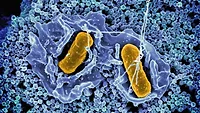Novel Technology Shows Promise as Scalable PFAS Decontamination Method for Water

University of Rochester scientists have successfully demonstrated the ability of a novel electrocatalysis method to remove a harmful and pervasive type of per- and polyfluoroalkyl substance (PFAS) from water. Unlike existing methods, the new approach uses nonprecious metals, and could be scalable at a hundredth of the cost.
The research team is led by Astrid M. Müller, Ph.D., Assistant Professor of Chemical Engineering at the University of Rochester.
Also known as “forever chemicals” due to their inability to break down, PFAS have been an issue of increasing concern as they become more pervasive in the environment and humans, and as evidence begins to mount about their harms to human health, including, but not limited to, developmental disruptions and cancer. The chemicals are used in clothes, food packaging, firefighting foams, and other products, although their use in consumer goods is beginning to be phased out by industry and targeted by legislators and regulatory bodies.
For their study, the University of Rochester researchers targeted perfluorooctane sulfonate (PFOS), a type of PFAS that is now widely banned because of its toxicity but still persists in the environment and in drinking water. When they tested their novel electrocatalysis approach against contaminated water, complete defluorination of PFOS was achieved.
The novel approach is based on nanocatalysts, created from laser-made nanomaterials. First, pulsed laser in liquid synthesis allowed the researchers to control the surface chemistry of the catalysts in a way that is impossible with traditional wet chemistry methods. The researchers then manipulated the size of resulting nanoparticles through light-matter interaction, and adhered the nanoparticles to hydrophilic carbon paper to create a cheap substrate with high surface area. Finally, using lithium hydroxide at high concentrations, the scientists completely defluorinated the PFOS chemicals.
Large-scale water treatment using existing methods that require boron-doped diamond would cost an estimated $8.5 million per cubic meter of polluted water. At the same scale, the University of Rochester team’s novel technology would cost nearly 100 times less than existing methods, because it is based on nonprecious metals.
In future studies, Dr. Müller wants to explore why lithium hydroxide works so well for defluorination, and whether other, less expensive, and more widely available materials can be used to further improve the technology. She also hopes to test the method against other PFAS chemicals of concern.
Looking for quick answers on food safety topics?
Try Ask FSM, our new smart AI search tool.
Ask FSM →









